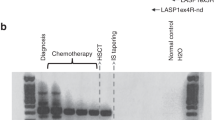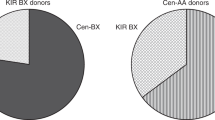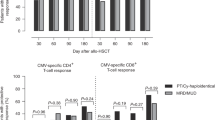Abstract
Chronic myeloid leukaemia (CML) can be treated successfully with allogeneic bone marrow transplantation (BMT) leading to long-term disease-free survival. Leukemia relapse, however, remains a significant clinical problem. Relapse following BMT presumably results from the expansion of small numbers of recipient leukaemic cells which have survived the conditioning therapy. In order to define patients who are at a high risk of leukaemia relapse, a variety of techniques have been employed to detect persistence of host haemopoiesis (mixed chimaerism, MC) or residual leukaemia (minimal residual disease, MRD). However, the precise relationship between the detection of MC and MRD post-BMT is unknown. We have investigated chimaerism and MRD status in 22 patients who were in clinical and haematological remission post-allogeneic BMT for chronic phase CML. Chimaerism was assessed using short tandem repeat PCR (STR-PCR) while BCR-ABL mRNA detection using reverse transcriptase polymerase chain reaction (RT-PCR) was performed to detect the presence of MRD. Seventeen patients received unmanipulated marrow (non-TCD) while in five patients a T cell-depleted transplant (TCD) was performed as additional GVHD prophylaxis. Chimaerism was evaluated in 18 patients (14 non-TCD, four TCD). Mixed chimaerism was an uncommon finding in recipients of unmanipulated BMT (21%) when compared to TCD BMT (100%). No evidence of MRD, as identified using the BCR-ABL mRNA RT-PCR assay, was detected in those patients who were donor chimaeras. Early and transient MC and MRD was detected in four patients (two non-TCD, two TCD) who have subsequently converted to a donor profile. One patient has stable low-level MC but remains MRD negative 4 years post-BMT. Late MC and MRD was observed in two patients who relapsed >6 years after TCD BMT for CML. We conclude that mixed chimaerism is a rare event in recipients of unmanipulated BMT and that donor chimaerism as detected by STR-PCR assay is consistant with disease-free survival and identifies patients with a low risk of leukaemic relapse post-BMT for CML.
This is a preview of subscription content, access via your institution
Access options
Subscribe to this journal
Receive 12 print issues and online access
$259.00 per year
only $21.58 per issue
Buy this article
- Purchase on Springer Link
- Instant access to full article PDF
Prices may be subject to local taxes which are calculated during checkout
Similar content being viewed by others
Author information
Authors and Affiliations
Rights and permissions
About this article
Cite this article
Gardiner, N., Lawler, M., O’Riordan, J. et al. Persistent donor chimaerism is consistent with disease-free survival following BMT for chronic myeloid leukaemia. Bone Marrow Transplant 20, 235–241 (1997). https://doi.org/10.1038/sj.bmt.1700861
Received:
Accepted:
Issue Date:
DOI: https://doi.org/10.1038/sj.bmt.1700861
Keywords
This article is cited by
-
How and when should we monitor chimerism after allogeneic stem cell transplantation?
Bone Marrow Transplantation (2005)
-
Analysis of haematopoietic chimaerism by quantitative real-time polymerase chain reaction
Bone Marrow Transplantation (2005)
-
Early complete donor hematopoietic chimerism in peripheral blood indicates the risk of extensive graft-versus-host disease
Bone Marrow Transplantation (2005)
-
Serial quantification of lymphoid and myeloid mixed chimerism using multiplex PCR amplification of short tandem repeat-markers predicts graft rejection and relapse, respectively, after allogeneic transplantation of CD34+ selected cells from peripheral blood
Leukemia (2003)
-
Chimerism and minimal residual disease monitoring after reduced intensity conditioning (RIC) allogeneic transplantation
Leukemia (2002)



